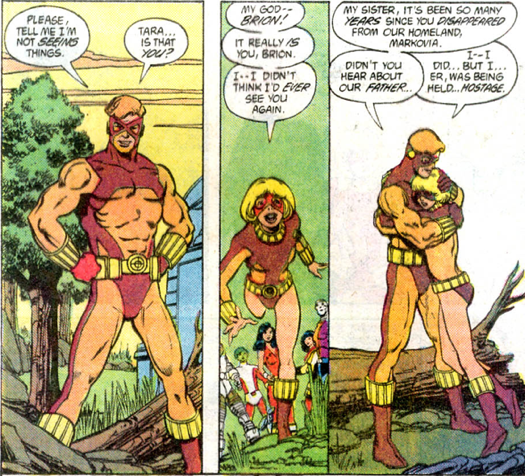
Jade was born in Vietnam to a local woman and either a French visitor or a U.S. senator, depending on which version of events she feeds you. She was sold into slavery as a child, but killed her master and went on to learn absolutely everything about poisons from an assassin named Kruen Musenda, to whom she was briefly married.
A criminal mastermind and international terrorist, Cheshire soon came to the attention of the Teen Titans, and the government sent Roy Harper (Speedy/Arsenal/Red Arrow/Arsenal/sigh) on an undercover mission to gain her confidence. However, they fell in love, and he walked out, knowing he could never turn her in. Later, he found that she had borne him a daughter, Lian, who he took custody of.
Unencumbered with a child, Cheshire decided to blackmail the world, Dr. Evil-style. To prove she was serious, she nuked the fictional nation of Qurac. She didn’t manage to collect her blackmail money, but escaped retribution and founded a team called the Ravens, who broke her out of jail after she was sentenced to life imprisonment. She then attempted to kill the senator she swore was her father, hoping to frame Lady Shiva for the crime and flee the country with Lian, but was stopped by the Birds of Prey.
She reemerged as a member of the Secret Six, blackmailed into joining by the mysterious Mockingbird, who threatened to kill Lian if she didn’t cooperate. Cheshire took matters into her own, um, hands, by sleeping with Catman and becoming pregnant. With a replacement child on the way, she betrayed the Six and disappeared to the Himalayas to raise her son, Thomas.
Despite this, when Lian was killed by Prometheus, Cheshire hunted down Roy and attacked him, blaming him for Lian’s death. She then lost her younger child when Thomas was kidnapped. Catman hunted down the kidnappers, ensured his son’s safety, and then told Cheshire that Thomas was dead to protect the boy from his mother.
Most recently, Cheshire has become a member of Deathstroke’s Titans, working with him and Roy in a complicated web of secrets and double-crosses.
So What’s So Great About Her?
As a villain, Cheshire is terrifying. Black Canary called her ‘the second most deadly assassin in the world,’ and when your competition is Lady Shiva, coming in second is no shame. She’s triple-jointed and trained in several lost martial arts, and just as capable with weapons as hand-to-hand. Moreover, when it comes to poison, she’s nearly as deadly as Poison Ivy, whose body manufactures it naturally; a bite or a scratch from her will leave you puking your guts out all night, and that’s if you’re lucky. She’s a master manipulator, always ready with a double cross, and totally unpredictable. And she’s utterly ruthless. I mean, she nuked a country to prove a point. A fictional country with a hilariously silly name, but still a country. And she does it all while wearing a dressing gown!
As a mother, Cheshire’s even more terrifying.
Oh, there’s no doubt she loves her children, for whatever given value of ‘love’ Cheshire is capable of feeling. On the one hand, that means she’ll let herself be apprehended to protect Lian. Aw, touching.
On the other hand, it means that she’ll contact an insanely convoluted revenge scheme against Black Canary because, as Lian’s sort-of aunt/sort-of grandma/general mother figure, Dinah gets to sing Lian to sleep and Cheshire doesn’t. Less touching.
When Lian’s life is used as a bargaining chip against her, Cheshire goes ahead and gets knocked up with what she literally calls a ‘replacement’ but when Lian is killed in an unrelated disaster, she tracks down Roy and lays her grief and rage at his feet. She’s not blasé about her children or their deaths, real or faked. She’s just determined to always stay one step ahead of her enemies.
All this adds up to a character who is super entertaining to read. She’s got just enough complexity to make her almost sympathetic and totally unpredictable, while still remaining dangerous to any hero she happens to be facing off with. She’s gleefully bad: she genuinely seems to enjoy what she’s doing, whether it’s dropping nukes or picking up stubbled ‘n’ troubled hero-types. And hey, you can’t fault her taste in baby daddies!
In conclusion, I’m really really glad Cheshire’s not real.
Notable Appearances:
New Teen Titans Annual #2
Tales of the Teen Titans #51-52
New Teen Titans v2 #20-21
Action Comics Weekly #613-618
Deathstroke the Terminator #17-20
Birds of Prey: Ravens
Birds of Prey v1 #4-6, 29
Titans v1 #10-12, 21-22, 30
Birds of Prey v1 #63-67
Villains United #1-6
Secret Six v2 #1-6
Secret Six v3 #1-7
The Rise of Arsenal #2-3
Secret Six v3 #19-24
Titans: Villains for Hire Special #1
Cheshire has been co-starring in Titans v2 since issue #24.



